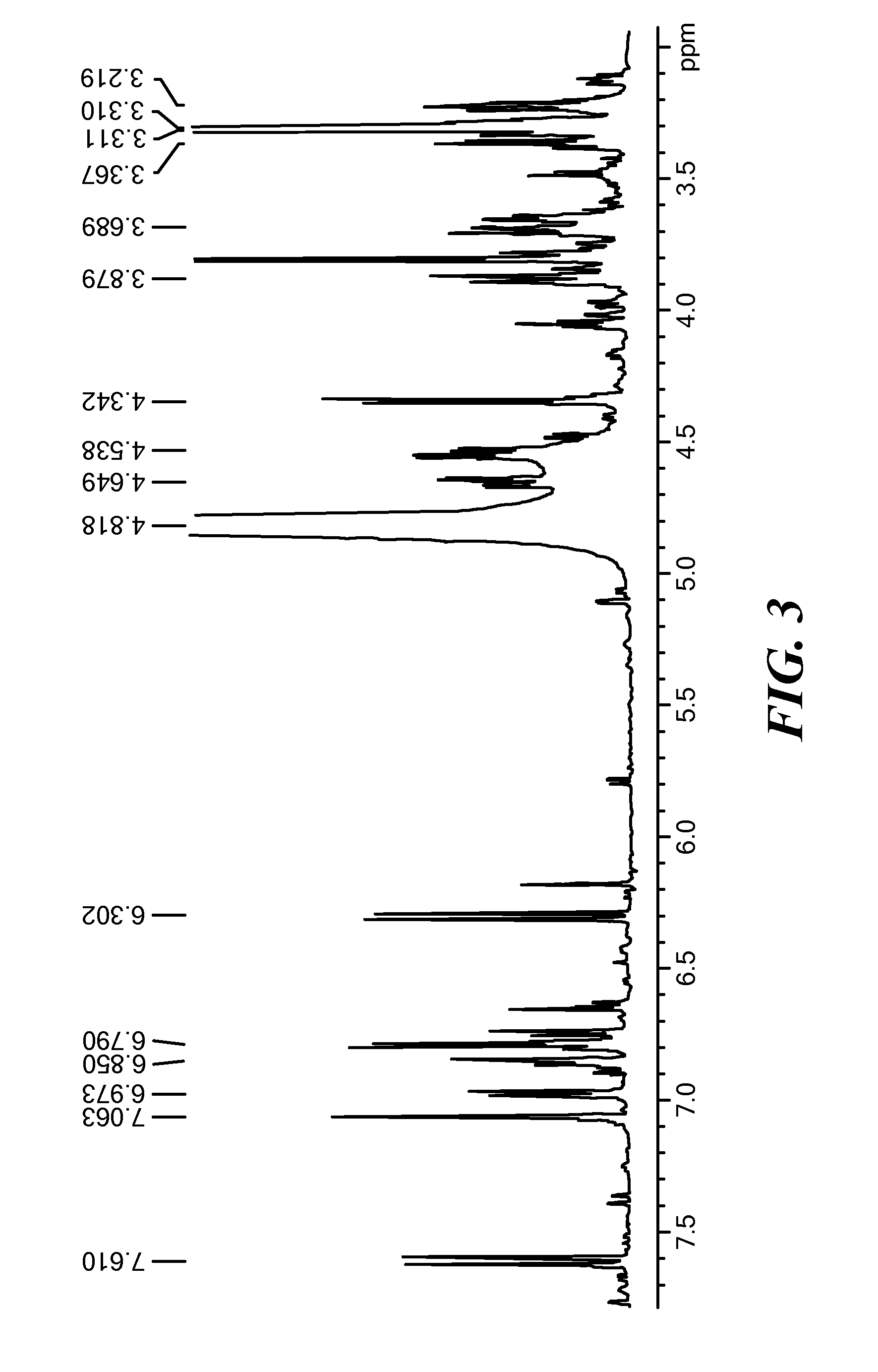Bioactive alkaloid compositions and their medical uses
a bioactive alkaloid and composition technology, applied in the field of new alkaloids and novel bioactive alkaloid fractions, can solve the problems of complex and dynamic wound healing process, community facing serious challenges, and affecting the health of patients, and achieve the reduction of pain in the first metatarsophalangeal joint of both feet, and the pain in the first metatarsophalangeal joint is reduced
- Summary
- Abstract
- Description
- Claims
- Application Information
AI Technical Summary
Benefits of technology
Problems solved by technology
Method used
Image
Examples
example 1
Objective
[0182]The objective of the current series of experiments was to isolate the alkaloids Ribetril A, Ribetril B, Ribetril C, Ribetril D, Ribetril E, Glucoindol A and Glucoindol B from Ribes and to prepare extracts, juices and concentrates of Ribes comprising an increased mass fraction of the alkaloid fractions of the invention.
Raw Materials, Test Compounds and Chemicals
[0183]All chemicals employed were of standard analytical grade from diverse suppliers. In special cases suppliers are specified.
[0184]All samples of- Ribes rubrum and Ribes nigrum were provided by Asiros A / S, Copenhagen, Denmark (commercially grown in Denmark, Poland or Germany) or obtained from the genetic collection Pometet, University of Copenhagen, Denmark.
Preparation of Pure Alkaloids from Ribes Berries
[0185]500 g of berries (either Ribes rubrum or Ribes nigrum) were grinded and homogenized followed by extraction twice with 500 ml 2-propanol for 30 minutes under homogenization employing an IKA® T25 Digital ...
example 2
Objective
[0299]The objective of this study was to test the viability of different proportions of mixtures of concentrates / extracts of Ribes rubrum and Ribes nigrum by simply testing the stability of such mixtures after 3 months exposure to slightly elevated temperature (40 degrees C.).
Method
[0300]RAP16 and RAP17 were prepared in example 1.
[0301]10 g of mixtures of RAP16 and RAP17 were prepared in the proportions shown in the table below:
[0302]
RAP16% (by weight) RAP17% (by weight)59510 9015 8520 8025 7530 7035654060455550 5055 45604065357030752580 20851590 10955
[0303]All samples were stored in sterile glass containers for 90 days at elevated temperature (40 degrees C.).
[0304]A chemical profile of all samples was established before and after 90 days storage employing the HPLC-DAD-MS method described in Example 1.
Results
[0305]The chemical profiles of each mixture of RAP16 and RAP17 before and after storage at elevated temperature were compared. No differences were observed.
Conclusion
[0...
example 3
Objective
[0307]The objective of this study was the investigation of the in vitro inhibitory effect of isolated alkaloids of the invention on IkappaB kinase β (IKK-β).
Background
[0308]IKK-β phosphorylates the inhibitory IκB protein associated with NF-κB. Phosphorylation results in the dissociation of IκB from NF-κB, allowing NF-κB to migrate into the cell nucleus where it can activate the transcription of at least 150 genes. The Z9-LYTE™ Kinase Assay Kit—Ser / Thr 5 Peptide is designed to screen for potential IKK-β inhibitory effect using fluorescence resonance energy transfer (FRET) between coumarin and fluorescein for detection by a fluorometer.
Method
[0309]The assay was performed according to Z9-LYTE™ KINASE ASSAY KIT—SER / THR 5 PEPTIDE protocol provided by Invitrogen [Invitrogen, Z′-LYTE™ Kinase Assay Kit—Ser / Thr 5 Peptide Protocol, O-062187-r1 US 0405]. Based on the IKK-β certificate of the kit, a kinase concentration of 500 ng / ml was chosen. Km for ATP 9.4 μM was chosen according to...
PUM
| Property | Measurement | Unit |
|---|---|---|
| time | aaaaa | aaaaa |
| time | aaaaa | aaaaa |
| time | aaaaa | aaaaa |
Abstract
Description
Claims
Application Information
 Login to View More
Login to View More - R&D
- Intellectual Property
- Life Sciences
- Materials
- Tech Scout
- Unparalleled Data Quality
- Higher Quality Content
- 60% Fewer Hallucinations
Browse by: Latest US Patents, China's latest patents, Technical Efficacy Thesaurus, Application Domain, Technology Topic, Popular Technical Reports.
© 2025 PatSnap. All rights reserved.Legal|Privacy policy|Modern Slavery Act Transparency Statement|Sitemap|About US| Contact US: help@patsnap.com



